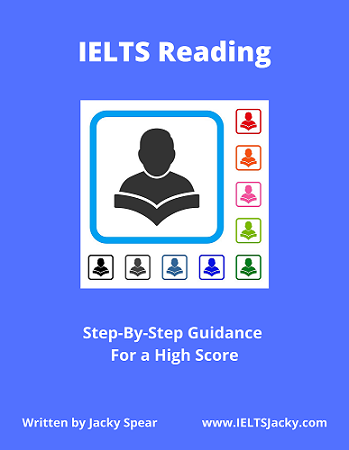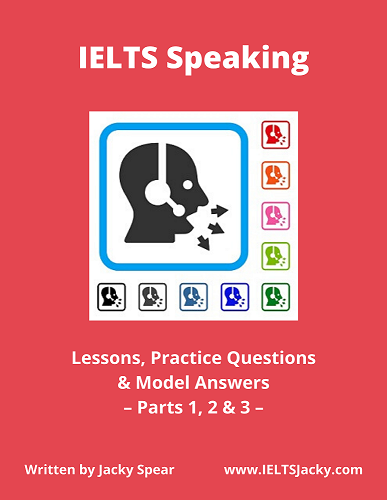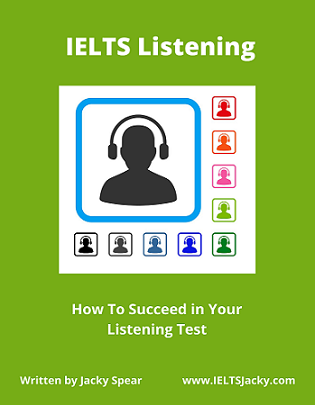IELTS
Academic Writing
–
How To Plan a Task 1 Essay –
The first step to achieving a high score in IELTS Academic Writing Task 1 is to know how to plan your essay. This is very important and in this lesson, I’m going to explain why and show you how.
The lesson includes:
- 3 reasons why you must plan your essay
- 4 simple steps of essay planning
- 4 part essay structure
- A sample essay written step-by-step
Many students get a far lower score than they’re capable of achieving simply because they either don’t know how to plan their Task 1 essay or they think that planning takes up time that is better spent writing the essay.
Here are three key reasons why you should plan.
3 Reasons Why You Must Plan Your Essay
1) Planning saves you time
If you plan your essay before you start writing, you will already know what you’re going to say and won’t need to keep stopping to think about the next idea. This means that you will be able to write much faster than if you don’t have a plan.
You only need to spend 5 minutes on the planning stage. That leaves 15 minutes to write and check your essay.
2) Planning results in a more relevant answer
25% of your marks are for task achievement. This includes,
- Identifying the main features
- Comparing the main features
- Answering the question appropriately
Planning before you start writing will ensure that you include everything that's required in your IELTS Academic Writing Task 1 essay.
3) Planning results in a better structure
Another 25% of the marks are for coherence and cohesion. This includes,
- Organizing your ideas into a logical order
- Having a separate paragraph for part of the essay
- Linking your paragraphs appropriately
You may have done a fantastic job of identifying the main features of the graphic, and found some great comparisons to write about, but you must also be able to form your ideas into a well-structured essay. Without a plan, this is difficult to achieve. Unless you have a good essay structure, you will not score highly for coherence and cohesion.
Spending a few minutes planning your essay will give you a basic outline to follow as you write. This will make your task a lot easier and lead to a far better essay, and a happy examiner.
The 5 Simple Steps of Task 1 Planning
There are 5 steps to writing a good essay for IELTS Academic Writing Task 1:
- Analyse the question
- Identify the main features
- Write an introduction
- Write an overview
- Write the details paragraphs
We’ll look at these in more detail below but first, I want to outline an easy to remember 4 part essay structure.
The 4 Part Essay Structure
You can use the same basic structure for all IELTS Academic Writing Task 1 questions. Ideally, your essay should have 4 paragraphs:
Paragraph 1 – Introduction
Paragraph 2 – Overview
Paragraph 3 – 1st main feature
Paragraph 4 – 2nd main feature
You are only required to write 150 words. You won’t score extra marks for writing a longer essay. It’s what you write that gains you marks.
With only 20 minutes allowed for the task, it’s important that you don’t try to include too many details. Having an essay structure to work with will help you with this. Aim for quality in your essay, not quantity – the right information written in a logical order.
We’re now ready to work through the 5 step planning process.
Planning a Task 1 IELTS Academic Writing Essay
# 1 Analyse the question
The format of every question in IELTS Academic Writing Task 1 is the same.
Here’s a typical question. The highlighted words will always be the same no matter what type of question you get.
The chart below shows the number of men and women in further education in Britain in three periods and whether they were studying full-time or part-time.
Summarise the information by selecting and reporting the main features, and make comparisons where relevant.
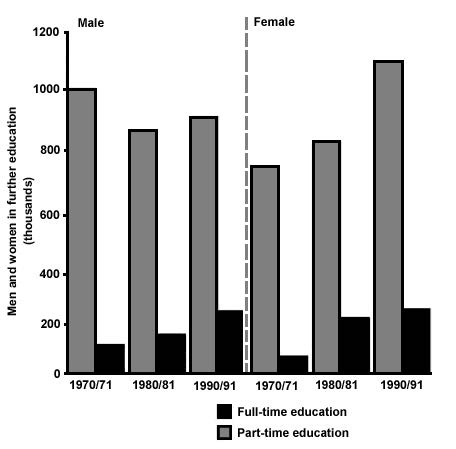
Every question consists of:
- A brief description of the graphic (sentence 1)
- The instructions (sentence 2)
- The graphic – chart, graph, table, etc.
To find out what you have to do, you need to look at the ‘instruction’ sentence.
Summarise the information by selecting and reporting the main features, and make comparisons where relevant.
There are 3 things to do:
1. Select the main features.
2. Write about the main features.
3. Compare the main features.
This is the same for every question and every type of graphic.
Many graphics contain a lot of information. You do not have to write about everything. Just pick out a couple of main features and you’ll have plenty to write about.
# 2 Identify the main features
In this lesson, I’m going to give you a quick overview of how to identify the main features of the graphics. I go into far more detail in the lessons on the individual question types where I work through sample questions step-by-step to create model answers.
Here’s a reminder of the 7 question types. Click the links to go to each page for more planning tips.
I’ve created helpful checklists for identifying the main features of the different types of IELTS Academic Writing Task 1 questions. You’ll find them on this page: How To Understand & Analyse Task 1 Questions
The key features of a graphic will usually be the easiest things to spot.
For a bar chart with a timeline, known as a dynamic bar chart, such as in our sample question, look for general trends. The timeline will give you the biggest clues as to the most significant trends.
Alternatively, a bar chart may be static with the data coming from one point in time. For this type of graphic, you would need to compare whatever different variables are shown. In the in-depth lesson on bar chart essays, for example, you'll see a graph showing the different leisure activities favoured by Canadian boys and girls.
There will be lots of information in the graphic to help you spot the main features. Here are some useful questions to ask for both bar charts and line graphs.
- What information do the 2 axes give?
- What are the units of measurements?
- What can you learn from the title and any labels?
- What are the time periods?
- What is the most obvious trend?
- What are the most notable similarities or differences?

Two general trends in this graphic are:
Main feature 1: the overall number of students in full-time education increases.
Main feature 2: the number of women studying part-time increases steadily but for men, it fluctuates.
The general trends you select will be the starting point for your essay. You will then go on to add more detail.
Let’s look at how to do this. Here’s a reminder of the 4 part structure for IELTS Academic Writing Task 1 essays:
Paragraph 1 – Introduction
Paragraph 2 – Overview
Paragraph 3 – 1st main feature
Paragraph 4 – 2nd main feature
This structure isn’t going be an exact fit for every possible essay but it’s an excellent outline to work from. Use it as a guideline and adapt it as necessary.
First, the introduction.
# 3 Write an introduction (Paragraph 1)
In the introduction, you should paraphrase the question, that is, say the same thing in a different way. You can do this by using synonyms and changing the sentence structure. For example:
Question:
The chart below shows the number of men and women in further education in Britain in three periods and whether they were studying full-time or part-time.
Introduction:
The bar graph illustrates how many male and female students were studying full-time and part-time in Britain during the years 1970/1, 1980/1 and 1990/1.
This is all you need to do for the introduction.
# 4 Write an overview (Paragraph 2)
In the second paragraph, you should report the main features you can see in the graph, giving only general information. The detail comes later in the essay. You should also make any clear comparisons you spot.
This is where you write about the general trends. Here are the ones we picked out above.
Main feature 1: the overall number of students in full-time education increases.
Main feature 2: the number of women studying part-time increases steadily but for men, it fluctuates.
Now form these ideas into two or three sentences with a total of around 40 words. State the information simply using synonyms where possible. No elaborate vocabulary or grammar structures are required, just the appropriate words and correct verb tenses. For example:
Paragraph 2:
Overall, the number of students in full-time education increased over this time. With regard to part-time education, there was a steady increase in women choosing to study part-time but for men, the level fluctuated.
# 5 Write the details paragraphs (Paragraphs 3 & 4)
Paragraphs 3 and 4 are where you include more detailed information about the data in the graph. In paragraph 3, you should give evidence to support your first main idea.
In this instance, the data will be numbers of students in the respective time periods. In other graphics, it might be percentages, age, monetary value or some other unit of measurement.
Don’t forget to make comparisons when relevant.
Here’s our first main feature again:
Main feature 1: the overall number of students in full-time education increases.
This is an example of what you could write:
Paragraph 3:
Between the academic periods 1970/1 and 1990/1, the figures for men studying full-time grew in steady increments, beginning at 100,000 in 1970/1 and rising to nearly 300,000 in 1990/1. For women, the numbers had also risen to around 300,000 by 1990/1 on an increasing trend. Notably, however, the figure for females in full-time education in 1970/1 was roughly half that of men, showing a greater take-up than men between 1970/1 and 1980/1.
For the fourth and final paragraph, you do the same thing for your second main feature. For example:
Main feature 2: the number of women studying part-time increases steadily but for men, it fluctuates.
Paragraph 4:
A different pattern is shown for part-time education. The graph reveals a steady increase in women engaged in part-time study, rising from 750,000 in 1970/1 to 1,000,000 by 1990/1. For men, on the other hand, the figure fluctuated. From 1,000,000 in 1970/1, they had dropped by almost 200,000 by 1980/1 but recovered slightly in numbers by 1990/1. Over the whole time period, the trend between men and women in part-time education reversed, with male students being greater in number in 1970/1 and female students taking pole position by 1990/1.
Here are the four paragraphs brought together to create our finished essay for IELTS Academic Writing Task 1.
Finished essay
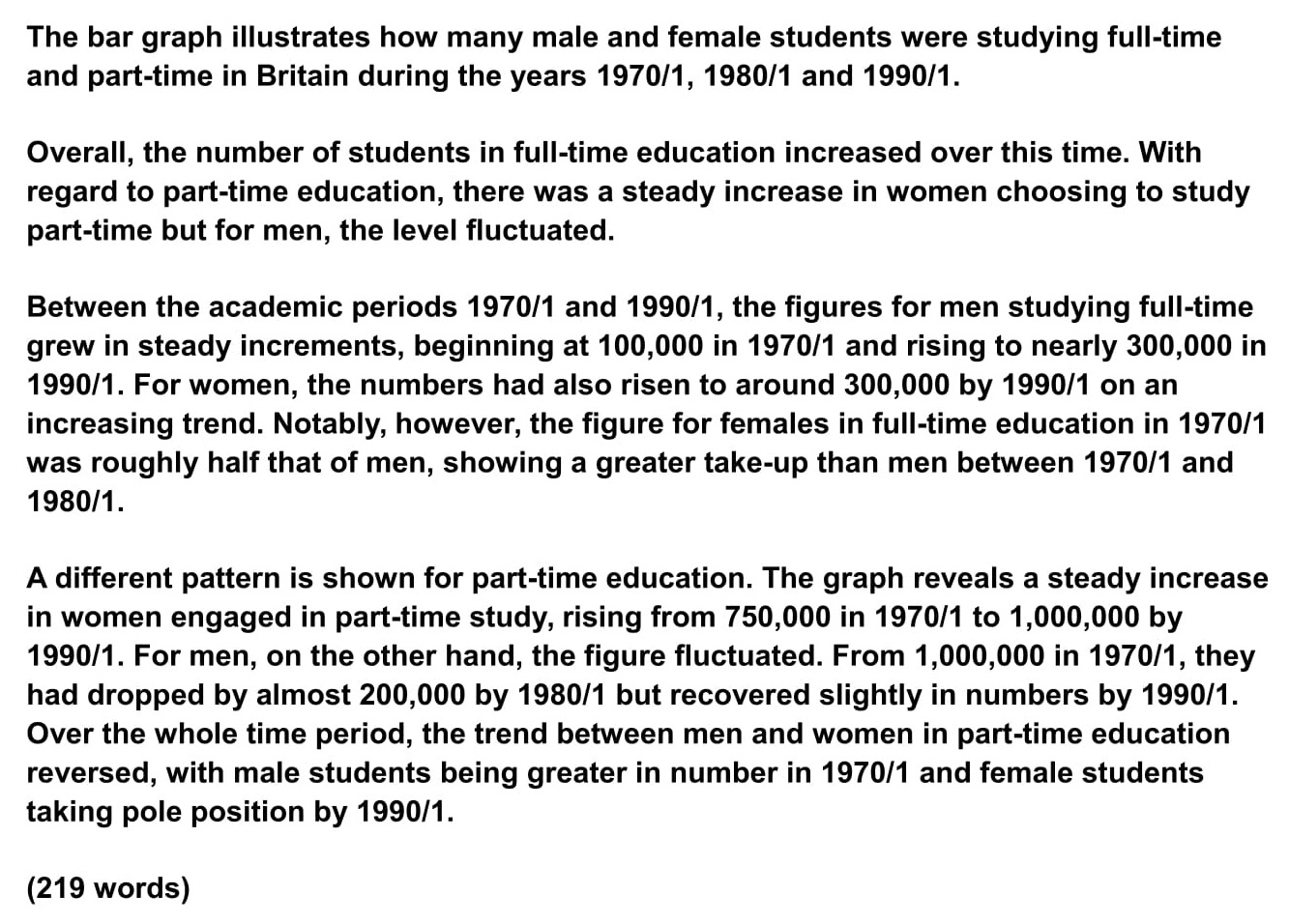
This sample essay is well over the minimum word limit so you can see that you don’t have space to include very much detail at all. That’s why it is essential to select just a couple of main features to write about.
We’ve covered a lot in this lesson. Please don’t feel overwhelmed. Once you start using what you’ve learnt to practice answering IELTS Academic Writing Task 1 questions, you’ll soon be able to plan your essay in 5 minutes.
Want to watch and listen to this lesson on IELTS Academic Writing Task 1?
Click on this video.
Like this page?
IELTS Academic Writing Task 1 – All Lessons
IELTS Academic Writing – A summary of the test including important facts, test format & assessment.
Academic Writing Task 1 – The format, the 7 question types & sample questions, assessment & marking criteria. All the key information you need to know.
Understanding Task 1 Questions – How to quickly and easily analyse and understand IELTS Writing Task 2 questions.
How To Plan a Task 1 Essay – Discover 3 reasons why you must plan, the 4 simple steps of essay planning and learn a simple 4 part essay structure.
Vocabulary for Task 1 Essays – Learn key vocabulary for a high-scoring essay. Word lists & a downloadable PDF.
Grammar for Task 1 Essays – Essential grammar for Task 1 Academic essays including, verb tenses, key sentence structures, articles & prepositions.
The 7 Question Types:
Click the links below for a step-by-step lesson on each type of Task 1 question.




